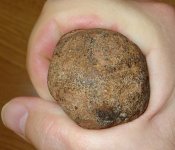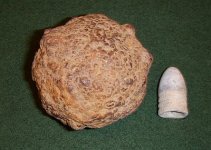Jritter wrote:
> PCGeorge, you do not think it was round to begin with but struck something, like a cannon for example, changing its shape?
I've previously studied that question, extensively, by investigating Metallurgy. The answer to the question is definitely No. Metallurgists call Cast-Iron a "brittle" metal, not a "malleable" (flexible) metal. Cast-Iron refuses to bend, flex, or "smush" (meaning, compress down or outward) upon even tremendous impact. Instead, it will break/shatter. That is why civil war bayonets, knife-blades, and swords were made of Wrought-Iron (a malleable/flexible form or iron), instead of Cast-Iron. Sorry, but there is absolute certainty that your iron object's shape is not the result of "smushing" by impact on a cannon or anything else.
> It does seem to look similar to the "F" shots in the attached thumbnail.
The "F" item is two small (.5"-to.7" diameter) IRON artillery case-shot/canister balls which were manufactured by casting in a Gang-Mold (a type of metal-casting mold which produces multiple items each time it is filled with molten metal, instead of a single item like most molds do). The various cavities in the Gang-Mold are connected to each other by a small tunnel, allowing the molten metal to flow into all the cavities. When the mold is opened and the "gang" of connected iron balls gets removed, the maker whacks them with a heavy hammer, breaking them loose from each other. But sometimes, the maker wasn't diligent enough to break every ball loose from its neighbor.
In the photo, the somewhat "smushed" shape of balls A, C, and E shows that they are lead balls, a metal which is malleable/flexible enough for its shape to be changed by impact. (As we see with fired lead musketballs and Minie-balls.)
> Would the Union or Confederate army have used a coal crushing device on the battlefield, or had one with them?
No... pulverized coal was used for creating the super-hot fire needed to melt iron, copper, & brass in a Metal Foundry's work. An army in the field had no need to pulverize coal. Civil war armies did have Blacksmiths, but their job only involved heating iron enough to bend it into another shape -- such as horseshoes -- not to melt it for doing Metalcasting.
About how your definitely non-military "bumpy" iron ball got to where you found it:
Probably for the reason of simple "convenience" in rural areas, old (no-longer-needed) rock-crusher balls and cement-truck-tank-cleaner balls have frequently gotten dumped (disposed of) in country fields and woods. I know personally that they've turned up in such places from time. For example, in my collection I own a lump of cement/concrete which has several cement-truck-tank-cleaner balls showing in it. A relic-hunter found it at the edge of an abandoned farm-field at the Chancellorsville VA battle site.
Regards,
Pete [P.C. George]






